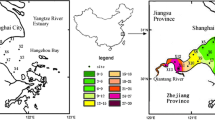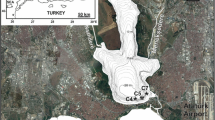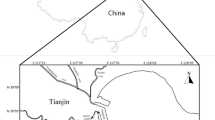Abstract
The residual levels of dichlorodiphenyltrichloroethane (DDT) and its metabolites (DDXs, including p,p′-DDT, DDD, and DDE) in water, suspended particulate matter (SPM), and sediments from major rivers, lakes, and reservoirs in Haihe Plain were measured with a gas chromatograph equipped with a 63Ni microelectron capture detector. In the fall of 2004, the contents of the total DDXs in the water and SPM were 0.29 ± 0.69 ng L−1 and 423.13 ± 577.85 ng g−1 dry wt., respectively. In the spring of 2005, the total DDXs were 0.36 ± 0.91 ng L−1 for water and 35.93 ± 62.65 ng g−1 dry wt. for SPM. The average concentration of DDXs for sediments was 7.10 ± 7.57 ng g−1 dry wt. during the two seasons. The Eastern-Hebei-Province Coastland River System was the most polluted, which was mainly attributable to the extensive use of DDT pesticide and dicofol in that system. Recent DDT inputs still occur in some regions, as indicated by DDT/(DDD + DDE) > 1 at 29–36 % of the sites for water and 55–61 % of the sites for SPM. The potential ecological risks of DDT in the water were assessed using a species sensitivity distribution model. Only shrimp and crabs were found to have potentially affected fraction values of 1.63 × 10−3 to 2.27 × 10−4, with probabilities beyond the hazardous concentration for 5 % of species (HC5) values of 1.90–2.56 %, suggesting only slight risks. DDXs in the sediments of some sites were also of potential risk to benthic organism based on consensus-based sediment quality guidelines.







Similar content being viewed by others
References
Chau, K. W. (2005). Characterization of transboundary POP contamination in aquatic ecosystems of Pearl River delta. Marine Pollution Bulletin, 51, 960–965.
Chen, J. W., Liu, C., Yang, Z. F. & Wang, J. Y. (2008). Residues and characteristics of organochlorine pesticides in surface water in the suburb of Beijing. Earth Science Front 15(5), 242–247.
CSIRO (Australia’s Commonwealth Scientific and Industrial Research Organisation) (2008). A flexible approach to species protection. http://www.cmis.csiro.au/envir/burrlioz/.
Doong, R. A., Lee, S. H., Lee, C. C., Sun, Y. C., & Wu, S. C. (2008). Characterization and composition of heavy metals and persistent organic pollutants in water and estuarine sediments from Gao-ping River, Taiwan. Marine Pollution Bulletin, 57, 846–857.
Feng, K., Yu, B. Y., Ge, D. M., Wong, M. H., Wang, X. C., & Cao, Z. H. (2003). Organochlorine pesticide (DDT and HCH) residues in the Taihu Lake Region and its movement in soil–water system I. Field survey of DDT and HCH residues in ecosystem of the region. Chemosphere, 50, 683–687.
Gao, J. J., Liu, L. H., Liu, X. R., Lu, J., Zhou, H. D., Huang, S. B., Wang, Z. J., & Spear, P. A. (2008). Occurrence and distribution of organochlorine pesticides—lindane, p, p′-DDT, and heptachlor epoxide—in surface water of China. Environmental International, 34, 1097–1103.
Gomez-Gutierrez, A. I., Jover, E., Bodineau, L., Albaiges, J., & Bayona, J. M. (2006). Organic contaminant loads into the Western Mediterranean Sea: estimate of Ebro River inputs. Chemosphere, 65, 224–236.
Gustafson, K. E., & Dickhut, R. M. (1997). Distribution of polycyclicaromatic hydrocarbons in Southern Chesapeake Bay surface water: evaluation of three methods for determining freely dissolved water concentration. Environmental Toxicology and Chemistry, 16, 452–461.
Hitch, R. K., & Day, H. R. (1992). Unusual persistence of DDT in some western USA soils. Bulletin of Environmental Contamination and Toxicology, 48, 259–264.
Kurt-Karakus, P. B., Bidleman, T. F., Staebler, R. M., & Jones, K. C. (2006). Measurement of DDT fluxes from a historically treated agricultural soil in Canada. Environmental Science and Technology, 40, 4578–4585.
Li, X. M., Zhang, Q. H., Dai, J. Y., Gan, Y. P., Zhou, J., Yang, X. P., Cao, H., Jiang, G. B., & Xu, M. Q. (2008). Pesticide contamination profiles of water, sediment and aquatic organisms in the effluent of Gaobeidian wastewater treatment plant. Chemosphere, 72, 1145–1151.
MacDonald, D. D., Ingersoll, C. G., & Berger, T. A. (2000). Development and evaluation of consensus-based sediment quality guidelines for freshwater ecosystems. Archives of Environmental Contamination and Toxicology, 39, 20–31.
Pandit, G. G., Sahu, S. K., Sharma, S., & Puranik, V. (2006). Distribution and fate of persistent organochlorine pesticides in coastal marine environment of Mumbai. Environmental International, 32, 240–243.
Pinkney, A. E., & McGowan, P. C. (2006). Use of the p, p′-DDD: p, p′-DDE concentration ratio to trace contaminant migration from a hazardous waste site. Environmental Monitoring and Assessment, 120, 559–574.
Posthuma, L., Traas, T. P., & Suter, G. W. (2002). General introduction to species sensitivity distributions. In: Species sensitivity distributions in ecotoxicology (Eds.) (pp. 3–9). FL: Lewis, Boca Raton.
Qiu, Y. W., Zhang, G., Guo, L. L., Cheng, H. R., Wang, W. X., Li, X. D., & Wai, O. W. H. (2009). Current status and historical trends of organochlorine pesticides in the ecosystem of Deep Bay, South China. Estuarine, Coastal and Shelf Science, 85(2), 265–272.
Shi, Y., Meng, F. & Guo, F. (2005). Residues of organic chlorinated pesticides in agricultural soils of Beijing, China. Archives of Environmental Contamination and Toxicology, 49, 37–43.
Sun, J. H., Feng, J. L., Liu, Q., & Li, Q. L. (2010). Distribution and sources of organochlorine pesticides (OCPs) in sediments from upper reach of Huaihe River, East China. Journal of Hazardous Materials, 184, 141–146.
Tan, L., He, M. C., Men, B., & Lin, C. Y. (2009). Distribution and sources of organochlorine pesticides in water and sediments from Daliao River estuary of Liaodong Bay, Bohai Sea (China). Estuarine, Coastal and Shelf Science, 84, 119–127.
Tang, Z. W., Yang, Z. F., Shen, Z. Y., Niu, J. F., & Cai, Y. P. (2008). Residues of organochlorine pesticides in water and suspended particulate matter from the Yangtze River catchment of Wuhan, China. Environmental Monitoring and Assessment, 137, 427–439.
Tao, S. Li, B. G., He, X. C., Liu, W. X., & Shi, Z. (2007). Spatial and temporal variations and possible sources of dichlorodiphenyltrichloroethane (DDT) and its metabolites in rivers in Tianjin, China. Chemosphere, 68, 10–16.
Tao, S., Liu, W. X., Li, Y., Yang, Y., Zuo, Q., Li, B. G., & Cao, J. (2008). Organochlorine pesticides contaminated surface soil as reemission source in the Haihe Plain, China. Environmental Science & Technology, 42, 8395–8400.
Wan, Y., Hu, J. Y., Liu, J. L., An, W., Tao, S., & Jia, Z. B. (2005). Fate of DDT-related compounds in Bohai Bay and its adjacent Haihe Basin, North China. Marine Pollution Bulletin, 50, 439–445.
Wang, X. T., Chu, S. G., & Xu, X. B. (2003). Organochlorine pesticide residues in water from Guanting Reservoir and Yongding River, China. Bulletin of Environmental Contamination and Toxicology, 70(2), 351–358.
Wang, B., Yu, G., Huang, J., & Hu, H. Y. (2008). Development of species sensitivity distributions and estimation of HC5 of organochlorine pesticides with five statistical approaches. Ecotoxicology, 17, 716–724.
Wang, Y., Wang, J. J., Qin, N., Wu, W. J., Zhu, Y., & Xu, F. L. (2009). Assessing ecological risks of DDT and lindane to freshwater organisms by species sensitivity distributions. Acta Scientiae Circumstantiae, 29, 2407–2414.
Wang, W., Tang, X. Q., Huang, S. L., Zhang, S. H., Lin, C., Liu, D. W., Che, H. J., Yang, Q., & Scholz, M. (2010). Ecological restoration of polluted plain rivers within the Haihe River Basin in China. Water, Air, and Soil Pollution, 211, 341–357.
Wong, M. H., Leung, A. O. W., Chan, J. K. Y., & Choi, M. P. K. (2005). A review on the usage of POP pesticides in China: with emphasis on DDT loadings in human milk. Chemosphere, 60, 740–752.
Wu, Y., Zhang, J., & Zhou, Q. (1999). Persistent organochlorine residues in sediments from Chinese river/estuary systems. Environmental Pollution, 10, 143–150.
Xing, B. S. & Pignatello, J. J. (1998). Competitive sorption between 1,3-dichlorobenzene or 2,4-dichlorophenol and natural aromatic acids in soil organic matter. Environmental Science & Technology, 32, 614–619.
Xu, D., Deng, L. & Chai, Z. (2004). Organohalogenated compounds in pine needles from Beijing City, China. Chemosphere, 57, 1343–1353.
Xu, D., Dan, M., & Song, Y. (2005). Concentration characteristics of extractable organohalogens in PM2. 5 and PM10 in Beijing, China. Atmosphere Environment, 39, 4119–4412.
Xu, G. F., Ma, L. L., Xu, D. D., Li, S. Z., Yao, D. X. & Shi, W. Q. (2009). Characteristics and sources of dissolved organochlorine pesticides in the rainwater in Beijing (in Chinese). China Environmental Sciences, 29(11), 1153–1157.
Yang, Q. S., Mai, B. X., Fu, J. M., Sheng, G. X., & Wang, J. X. (2004). Spatial and temporal distribution of organochlorine pesticides (OCPs) in surface water from the Pearl River. Artery Estuary (in Chinese). Environmental Science, 25, 150–156.
Yang, R. Q., Jiang, G. B., Zhou, Q. F., Yuan, C. G., & Shi, J. B. (2005a). Occurrence and distribution of organochlorine pesticides (HCH and DDT) in sediments collected from East China Sea. Environmental International, 31, 799–804.
Yang, R. Q., Lv, A. H., Shi, J. B., & Jiang, G. B. (2005b). The levels and distribution of organochlorine pesticides (OCPs) in sediments from the Haihe River, China. Chemosphere, 61, 347–354.
Yu, H., Zhu, Z. & Zhao, X. (2003). Levels of organochlorine pesticides in Beijing human milk. Bull Environ Contam Toxicol 70, 193–197.
Zhang, G., Parker, A., House, A., Mai, B., & Li, X. (2002). Sedimentary records of DDT and HCH in the Pearl River delta, South China. Environmental Science & Technology, 36, 3671–3677.
Zhang, Z. L., Hong, H. S., Zhou, J. L., Huang, J., & Yu, G. (2003). Fate and assessment of persistent organic pollutants in water and sediment from Minjiang River Estuary, Southeast China. Chemosphere, 52, 1423–1430.
Zhang, Z. L., Huang, J., Yu, G. & Hong, H. S. (2004). Occurrence of PAHs, PCBs and organochlorine pesticides in the Tonghui River of Beijing, China. Environmental Pollution, 130, 249–261.
Zhao, L., Hou, H., Zhou, Y. Y., Xue, N. D., Li, H. Y., & Li, F. S. (2010). Distribution and ecological risk of polychlorinated biphenyls and organochlorine pesticides in surficial sediments from Haihe River and Haihe Estuary Area, China. Chemosphere, 78, 1285–1293.
Zhou, R., Zhu, L., Yang, K., & Chen, Y. (2006). Distribution of organochlorine pesticides in surface water and sediments from Qiantang River, East China. Journal of Hazardous Materials, 137, 68–75.
Zhou, R. B., Zhu, L. Z., & Chen, Y. Y. (2008). Levels and source of organochlorine pesticides in surface waters of Qiantang River, China. Environmental Monitoring and Assessment, 136, 277–287.
Zolezzi, M., Cattaneo, C., & Tarazona, J. V. (2005). Probabilistic ecological risk assessment of 1,2,4-trichlorobenzene at a former industrial contaminated site. Environmental Science & Technology, 39, 2920–2926.
Acknowledgments
Funding was provided by the National Science Fund for Distinguished Young Scholars (no. 40725004), the National Basic Research Program (973 Project) (no. 2007CB407304), the National Natural Science Foundation of China (41030529 and 40671165), the Ministry of Environmental Protection (201009032), and the Ministry of Education (20100001110035).
Author information
Authors and Affiliations
Corresponding author
Rights and permissions
About this article
Cite this article
Wang, Y., He, W., Qin, N. et al. Distributions, sources, and ecological risks of DDT-related contaminants in water, suspended particulate matter, and sediments from Haihe Plain, Northern China. Environ Monit Assess 185, 1777–1790 (2013). https://doi.org/10.1007/s10661-012-2667-0
Received:
Accepted:
Published:
Issue Date:
DOI: https://doi.org/10.1007/s10661-012-2667-0




